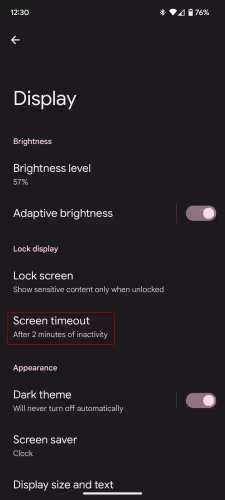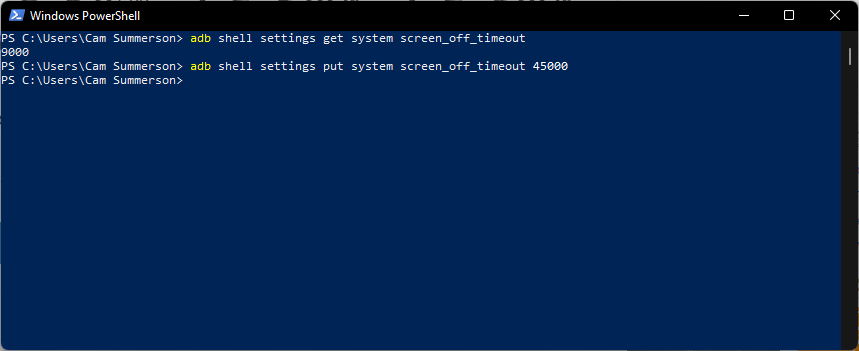You can set the Android screen timeout as low as 15 seconds or as high as 30 minutes — or you can disable it completely. But if you want to leave the screen on all the time, not all Android devices offer the option. You can work around this limitation with ADB or more advanced device management tools.
Manage Android Devices with Esper
How to change screen timeout settings on Android
Regardless of whether you want to lengthen or shorten the screen timeout on Android, the process is the same. Depending on the brand of device, the process can vary slightly. These instructions were written using a Google Pixel smartphone, and the differences are noted for Samsung Galaxy devices where needed.
To get started, open the Settings app. From there, scroll down to Display.

In the Display settings menu, look for the Screen Timeout settings option. Tap in and choose the timeout duration that best suits your needs — the default is 30 seconds, but you can adjust to 15 seconds, one minute, two minutes, five minutes, 10 minutes, and even 30 minutes.


Some devices may also include a “none” option here, which completely disables the timeout so the screen stays on all the time. For Android devices without the option to disable screen timeout entirely in the settings app, there is no guaranteed method to force the display on all the time. However, the display timeout can be changed or set so long as to be effectively unlimited with Android’s ADB command line tool, as shown below.
How to adjust screen timeout settings with ADB
If you’d rather adjust the screen timeout with the command line, you can use ADB. This is beneficial if you need to tweak timeout settings on multiple devices, as you can simply execute the same command on each one. It’s also helpful if you want a custom screen timeout duration not offered in Android’s settings menu, as you can set any specific number you want here.
First, plug your device into the computer you have ADB set up on (if you don’t have it set up, check out our primer).
To check the currently set screen timeout on the device, use the following command:
adb shell settings get system screen_off_timeout

This will output the display timeout in milliseconds.
To adjust that, use this command:
adb shell settings put system screen_off_timeout XXX
Use your desired timeout in place of XXX, again using milliseconds. For example, 12 hours would be 43200000 milliseconds. 24 hours would be 86400000. The max value is 2147483647 (roughly 597 hours).

This setting is mirrored in Android’s Display Settings menu, but if you use a custom option (like 45 or 90 seconds, for example), it will just read “Screen Timeout after null of inactivity.”
How to disable screen timeout completely
Unfortunately, many Android devices don’t offer a way to disable screen timeout completely — at least not in the default Display Settings menu. To completely disable screen timeout, you’ll need to enable Android’s hidden Developer Options menu.
Before you get started, there’s one big catch here: the device has to be plugged in for the display to stay on all the time using this method. Otherwise, the device will revert to the stock screen timeout setting. This makes it a pretty limited version of “always” on. Additionally, enabling developer options on your device could leave it vulnerable to tampering.
To set Android screen timeout to never:
- Open the Settings app
- Select About Phone (this is at the bottom of the Settings app main menu on most devices).
- For Galaxy devices, select Software information.
- Tap the build number seven times.
- You may need to enter your biometric or lock screen passcode info, but after that, a toast notification at the bottom of the screen will show a “congratulations, you are now a developer” message (if only it were so easy to actually become a developer).
Now, go back to the main Settings menu and tap on System. Scroll down — there should be a new entry titled Developer Options. To set Samsung screen timeout to never, Developer options will appear in the main Settings app menu below About phone.
Tap into this menu, then toggle the Stay Awake button.
Esper simplifies adjusting and disabling screen timeout settings — even on thousands of devices
If you need to adjust or disable screen timeout on a handful of devices, doing it manually is probably fine. But if you have to do it on dozens, hundreds, or even thousands of devices, there’s an easier way with Esper device management. Our unique grouping system and easy-to-use console make tweaking the display timeout for one device as dead simple as doing it for a thousand. Get in touch with us to learn more — or, better yet, sign up today and try us out. No commitment necessary.
Next-Gen MDM Solutions
FAQ
Yes. On most Android phones, you can find screen timeout settings in the Display menu.
Yes. Like on Android phones, you’ll find screen timeout settings in the Display menu of most Android tablets.
No. Screen time refers to the amount of time the screen has been on. Screen timeout refers to the window of time before the display automatically shuts off without interaction.
You can find screen timeout settings in the Display menu of most Android phones, tablets, and other devices.
Yes. On iPad, you can set the screen timeout auto lock to “never,” but this varies by manufacturer on Android.
Keep Exploring


















